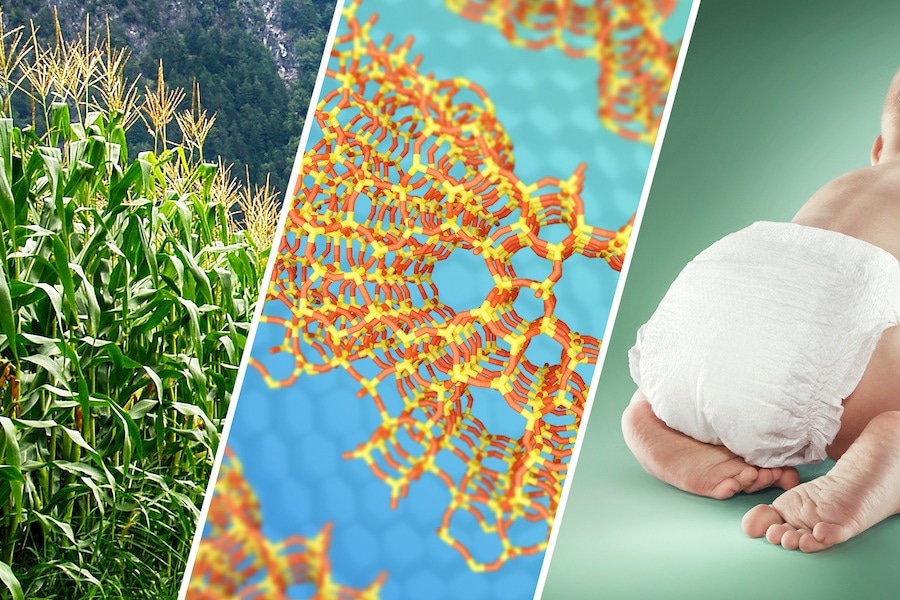Acrylic acid and acrylates are significant chemicals used in paints, coatings, and superabsorbent polymers. A team of scientists headed by the University of Minnesota Twin Cities researchers has created a game-changing new catalyst technology that converts renewable materials like trees and corn into these chemicals. Because of the new catalyst technology’s high efficiency, generating renewable chemicals will be less expensive.

University of Minnesota researchers have invented new catalyst technology that improves the process and substantially reduces the cost of manufacturing renewable chemicals that can be used in a wide range of products including paints, coatings, and diapers. Image Credit: John Beumer, NSF Center for Sustainable Polymers, University of Minnesota
With the highest yield to date, the novel catalyst formulation transforms corn-derived lactic acid-based compounds into acrylic acid and acrylates. When compared to other classes of top catalysts, the technology performs significantly better.
The study is published online in the Journal of the American Chemical Society Gold (JACS Au), a prominent open-access journal of the American Chemical Society.
The NSF Center for Sustainable Polymers, a multi-university collaborative group with the purpose of altering how plastics are manufactured, unmade, and remade via innovative research, provided funding for the study team.
Since it is used in so many everyday products, such as paints and coatings, sticky adhesives, and superabsorbent materials for diapers, the public is aware of acrylic acid and its related acrylates.
For the past century, fossil fuels have been used to create these chemicals and materials. But during the past few decades, the corn industry has expanded to produce important chemicals in addition to food and livestock feed. Sustainable lactic acid, a crucial component in the production of recyclable and compostable plastic, is one such corn-derived chemical.
Catalysts can also be used to transform lactic acid into acrylic acid and acrylates. Traditional catalysts, on the other hand, were extremely inefficient, producing low yields and driving up the cost of the process overall until this new catalyst was discovered.
Our new catalyst formulation discovery achieves the highest yield to date of acrylic acid from lactic acid. We benchmarked the performance of our new catalyst to all prior catalysts, and the performance far exceeds previous examples.
Paul Dauenhauer, Professor, Department of Chemical Engineering and Materials Science, University of Minnesota
By increasing productivity and decreasing waste, the novel catalyst composition significantly lowers the cost of producing renewable acrylic acid and acrylates from corn. This might drive the cost of renewable acrylic acid below those of chemicals obtained from fossil fuels for the first time.
Låkril Technologies, a startup firm aiming to develop low-cost renewable acrylic acid and acrylates, is pursuing the economic potential created by the novel catalyst. Låkril Technologies will expand the technique beyond the laboratory by licensing the catalyst technology from the University of Minnesota.
Chemical manufacturing has relied on a class of catalysts called ‘zeolites’ for half a century. Because the new catalyst discovery is based on a zeolite formulation already available at scale, our new process to make acrylic acid and acrylates will achieve low cost with low risk.
Dr Chris Nicholas, CEO, Låkril Technologies
Låkril Technologies, situated near Chicago, has already obtained $1.4 million in pre-seed funding to help it scale the technique. The Iowa Corn Growers Association led the financing, with Kentucky Corn Growers Association participation, as well as grants from the Minnesota Corn Research and Promotion Council, Indiana Corn Marketing Council, Corn Marketing Council of Michigan, and Small Business Innovation Research (SBIR) awards from both the US Department of Agriculture and Energy.
The researchers at the University of Minnesota intend to continue basic research on catalyst design to comprehend the underlying features of the chemistry, with financial support from the University of Minnesota’s Center for Sustainable Polymers.
This is a wonderful example of how addressing important basic research questions that are at the heart of fundamental catalysis can lead to innovative new processes that have true technological promise. A grand challenge in the Center for Sustainable Polymers is the efficient and sustainable conversion of biomass to polymer ingredients, and this work represents a groundbreaking solution to that challenge that will have lasting impact.
Marc Hillmyer, Director, Center for Sustainable Polymers
Marc Hillmyer is also a professor in the University of Minnesota’s Department of Chemistry.
Journal Reference
Pang, Y., et al. (2023) Multifunctional Amine Modifiers for Selective Dehydration of Methyl Lactate to Acrylates. JACS Au. doi.org/10.1021/jacsau.2c00513.